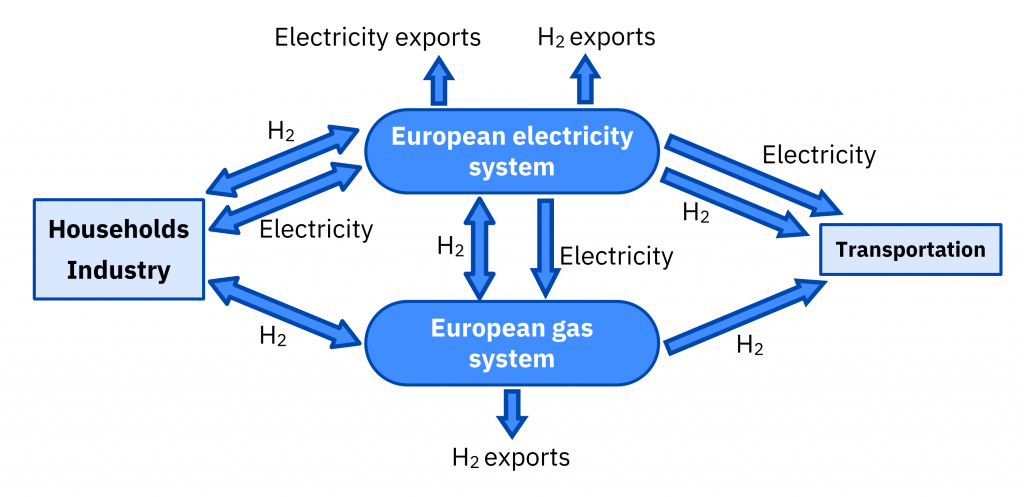

Its production is expected to introduce a floor in the electricity markets prices and also to avoid the curtailments of renewable energy. If there is the commitment to this technology, Spain has the opportunity to become the main production hub in southern Europe.
The role of the green hydrogen in the energy transition and in the decarbonisation of the economy was one of the topics highlighted in the analysis table of the Spanish version of the webinar “Prospects for the energy markets in Europe from 2021 (II)” which took place last Thursday, January 14, organised by AleaSoft and with the participation of experts from PwC. Following the questions from those registered at the webinar, the future of the hydrogen and its impact on the electricity markets prices were discussed.
The hydrogen has basically two markets. The first is that of those industries that use it as a raw material. This is the case of refineries, chemical and fertiliser industries and metallurgical industries. A change in the trend in hydrogen consumption is not expected from these industries.
But, on the other hand, there is the green hydrogen as a substitute for fossil fuels, mainly gas. The green hydrogen is that produced from renewable energy sources, so its generation does not emit CO2 or other greenhouse gases. This is the facet of hydrogen with extraordinary growth potential. The total decarbonisation of the economy, the objective of the European Union for 2050, will require the complete replacement of fossil fuels such as gas or oil and its derivatives.
These fossil fuels currently play a predominant role in sectors such as industry, transport and heating. The decarbonisation of these sectors will come in part from the electrification. But there are aspects in which the use of the electricity is not very efficient, such as the generation of heat for the industry or the heavy and long distances transport. In these cases, the hydrogen is postulated as the most suitable zero‑emission fuel. That is why the green hydrogen is called the fuel of the future.
In addition, the possibility of generating electricity directly from hydrogen and oxygen in a fuel cell makes the hydrogen a gas capable of storing energy, another essential aspect for the penetration of the intermittent and unmanageable renewable energies.
For all these reasons, the production of green hydrogen is expected to have an exponential growth in the coming decades, and its production is expected to have an impact on the electricity markets prices.
The green hydrogen production and the electricity market prices
The costs of the hydrogen production for it to be competitive with gas are estimated at around € 2 per kilo of hydrogen, although it will depend largely on the evolution of the gas and CO2 emission rights prices. To produce green hydrogen with these costs using electricity from renewable energy sources, the electricity price should be less than €20/MWh, always depending on how much the amortisation costs of the electrolysers are reduced. But, according to the experts, seeing the fall in CAPEX of this technology in recent years, it is not risky to expect drops of 30% or 35% in the coming years.
Similarly, it does not seem complicated that the electricity generation costs (LCOE) of technologies such as the photovoltaic technology could fall below €20/MWh in the near future. All this means that a virtual floor will appear in the electricity markets, a threshold below which the prices will not fall, since, at that price, the generators will decide to produce green hydrogen from which they will obtain income instead of selling the energy in the market at lower prices. This floor price is one of the keys to take into account when making long‑term hourly prices forecasting and giving the correct prices signals to the investors in renewable energy projects.
The curtailments in the renewable electricity production
The green hydrogen production will not only avoid recurring low prices in the electricity markets, but it will also avoid the curtailments of renewable energy. The curtailments are all the energy that is produced but does not end up entering the electricity grid because it is in surplus. Having an alternative such as the production of green hydrogen will make it possible not to waste all that surplus energy.
The batteries, or other energy storage technologies that may appear in the future, will also be necessary since, together with the hydrogen, they will reinforce this floor in the market prices and prevent larger curtailments.
The green hydrogen in the energy transition
According to the participants in the analysis table of the Spanish version of the webinar, for the hydrogen to develop its role in the energy transition, it will need the support of appropriate policies, investments, aids and regulatory changes. If there is the commitment to this, Spain has the opportunity to become the main green hydrogen production hub in the south of the continent for two reasons mainly.
On the one hand, due to the cost of generating the electricity, where Spain, thanks to the abundant solar resource, among others, can have more competitive prices than the rest of the markets. And, on the other hand, because the logistics cost of the transport has little weight in the final cost of the hydrogen when it is produced on a large scale.
If it really becomes the largest green hydrogen producing country, the experts estimate that up to 10 GW of renewable capacity in addition to those proposed in the NECP could be necessary, thanks to the production of hydrogen.
Source: AleaSoft
Follow on Twitter:
[tfws username=”AleaSoftEnergy_en” height=”700″ width=”350″ theme=”light” color=”#FAB81E” tweets=”2″ header=”yes” footer=”yes” borders=”yes” scrollbar=”yes” background=”yes”]













